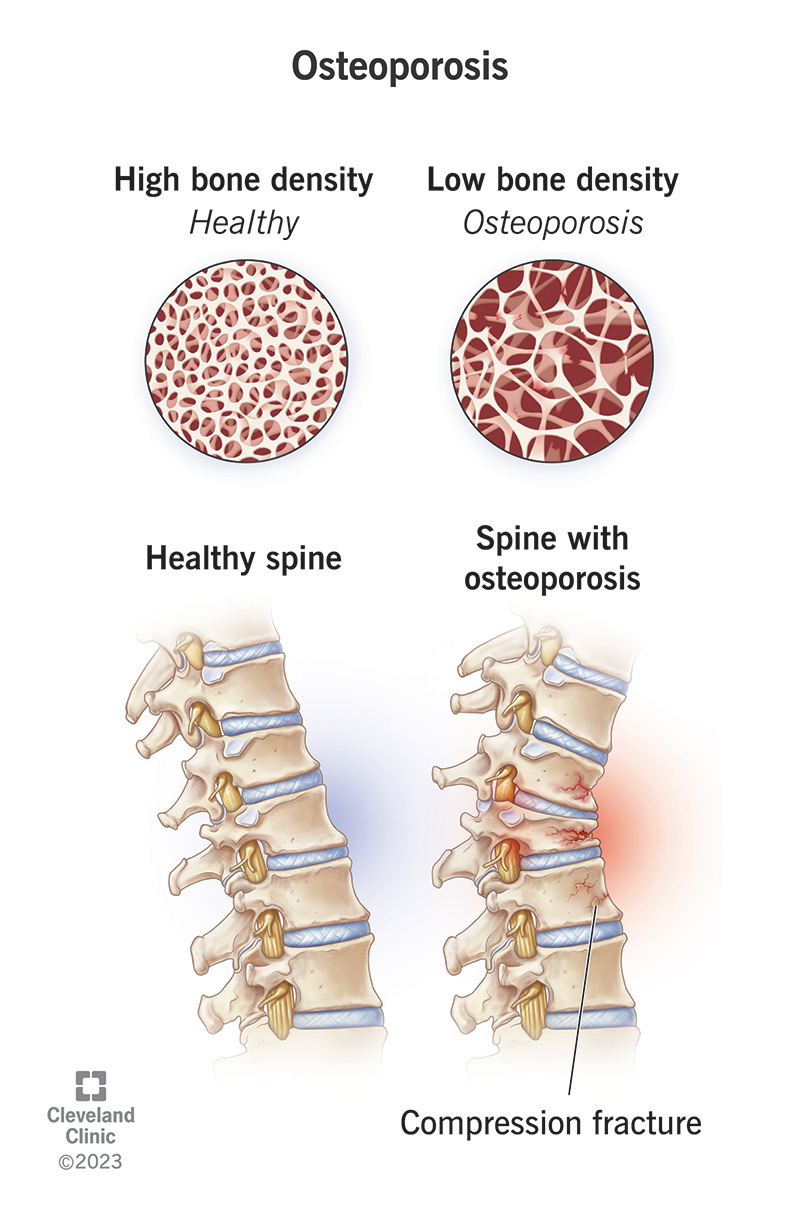A nurse is caring for an older adult client who has osteoporosis. Which of the following should the nurse recognize as the pathophysiology of osteoporosis?
Autoimmune disorder affecting the bones
Buildup of inflammation in the joints
Increase in calcium levels in the blood
Bone loss in the cortical and cancellous bones
The Correct Answer is D
Choice A Reason: Autoimmune disorder affecting the bones
Osteoporosis is not an autoimmune disorder. Autoimmune disorders involve the immune system attacking the body’s own tissues, which is not the case with osteoporosis. Osteoporosis is primarily characterized by a decrease in bone density and mass, leading to fragile bones.
Choice B Reason: Buildup of inflammation in the joints
While inflammation can affect bone health, osteoporosis is not primarily caused by inflammation in the joints. Conditions like rheumatoid arthritis involve joint inflammation, but osteoporosis involves the loss of bone density and strength, not joint inflammation.
Choice C Reason: Increase in calcium levels in the blood
An increase in calcium levels in the blood is not a characteristic of osteoporosis. In fact, osteoporosis often involves a decrease in bone calcium content, leading to weaker bones. Hypercalcemia, or high calcium levels in the blood, is associated with other conditions such as hyperparathyroidism.
Choice D Reason: Bone loss in the cortical and cancellous bones
This is the correct description of the pathophysiology of osteoporosis. Osteoporosis involves the loss of bone density in both the cortical (hard outer layer) and cancellous (spongy inner layer) bones. This loss leads to bones becoming brittle and more susceptible to fractures.

Nursing Test Bank
Naxlex Comprehensive Predictor Exams
Related Questions
Correct Answer is B
Explanation
Choice A Reason:
This option suggests that the gallbladder is blocked by a tumor. While tumors can cause blockages, they are not the most common cause of gallbladder inflammation requiring a cholecystectomy. Gallstones are a more frequent cause of such issues.
Choice B Reason:
This is the correct answer. Gallstones can block the common bile duct, leading to inflammation of the gallbladder, a condition known as cholecystitis. This blockage prevents bile from flowing out of the gallbladder, causing pain and potentially leading to infection.
Choice C Reason:
While cholesterol is a component of many gallstones, the inflammation of the gallbladder is typically due to the physical blockage caused by the stones rather than the cholesterol itself. The blockage leads to bile buildup and subsequent inflammation.
Choice D Reason:
Gallbladder infections caused by viruses are extremely rare. Most gallbladder infections are bacterial and occur secondary to blockages caused by gallstones.
Correct Answer is A
Explanation
Choice A Reason: WBC Count 22,000/mm³
A white blood cell (WBC) count of 22,000/mm³ is significantly higher than the normal range, which is typically between 4,000 and 11,000/mm³. An elevated WBC count, known as leukocytosis, often indicates the presence of an infection as the body produces more white blood cells to fight off pathogens. This elevated count can also be seen in other conditions such as inflammation, stress, or bone marrow disorders, but it is a strong indicator of infection.
Choice B Reason: Hgb 15 g/dL
Hemoglobin (Hgb) levels of 15 g/dL fall within the normal range for adults, which is generally 13.8 to 17.2 g/dL for males and 12.1 to 15.1 g/dL for females. Normal hemoglobin levels indicate that the blood’s oxygen-carrying capacity is adequate and do not specifically point to an infection.
Choice C Reason: Creatine kinase 75 units/L
Creatine kinase (CK) levels of 75 units/L are within the normal range, which is typically 24 to 204 U/L. CK is an enzyme found in the heart, brain, and skeletal muscle, and elevated levels can indicate muscle damage, myocardial infarction, or other conditions affecting these tissues. However, normal CK levels do not indicate the presence of an infection.
Choice D Reason: Platelet count 200,000/mm³
A platelet count of 200,000/mm³ is within the normal range, which is generally between 150,000 and 450,000 platelets per microliter of blood. Platelets are involved in blood clotting, and normal levels do not indicate an infection. Abnormal platelet counts can be associated with bleeding disorders or thrombosis, but a normal count does not suggest an infection.
Whether you are a student looking to ace your exams or a practicing nurse seeking to enhance your expertise , our nursing education contents will empower you with the confidence and competence to make a difference in the lives of patients and become a respected leader in the healthcare field.
Visit Naxlex, invest in your future and unlock endless possibilities with our unparalleled nursing education contents today
Report Wrong Answer on the Current Question
Do you disagree with the answer? If yes, what is your expected answer? Explain.
Kindly be descriptive with the issue you are facing.
